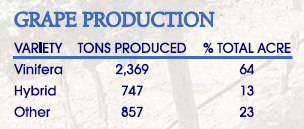Virginia Is For (Wine) Lovers - December 22, 2006
When you mention Virginia, wine is not the first thing that comes to mind. But one of the first things that DOES come to mind is Thomas Jefferson. And when you mention Thomas Jefferson to a wine lover, the wine connection to Virginia suddenly clicks. In today's column, I'll try to scratch the surface of what's what in Virginia wines. This article was prompted by my recent tasting of a case of select Virginia Viogniers and a recent tournament in Richmond, with a few winery visits folded in.
The history of Virginia wine growing goes back to 1773, when Filippo Mazzei sailed from Liverno,
Italy with grape cuttings from France, Spain, and Italy. The 30 year old Jefferson, already
a lover of fine European wines, convinced him to stay in Virginia and plant his vines on his property near Monticello. Alas, a killer frost nipped the buds of the young vines, and with it Jefferson's dream, the following Spring. And, if the Spring frost had not gotten them, the phylloxera bug would have
eventually brought their demise. The venture was doomed from the get-go.
The wine growing ventures for Virginia then entered a deep freeze for the next 190 years, only to emerge in the early 1970's, roughly about the time that New Mexico's modern wine industry was stirring from it's century-long slumber. Having followed this State's wine growth, the parallels with the Virginia and New Mexico wine industries are uncanny. In 1945, Philip Wagner published his book "A Wine-Grower's Guide", touting the use of French hybrids for wine production in areas where Winter kill presents a problem for the tender Vinifera.
 |
Thomas Jefferson |
French hybrids are a man-made cross between Vinifera and cold-hardy American species. The hope, never really realized, was that the quality of these wines would equal that of California and European wines from Vinifera. In the late '60's, there were scattered plantings of French hybrids in both Virginia and New Mexico. The vines thrived, but the wines were not up to most connoisseur's highfalutin' standards. Both nascent wine industries stagnated. It would be remiss to overlook the most famous of Virginia's wine in this era. This was Richard's Wild Irish Rose and Mother Vineyard Scuppernong, both made from that native American variety. Wildly aromatic and sickeningly sweet, it was a sipping wine only your little old Grandmother could love.
As in New Mexico, the Virginians realized that you COULD grow Vinifera, in properly chosen sites, and with careful vineyard practices to mitigate the effects of cold winters. This was first accomplished by de Treville Lawrence in The Plains, VA. Though some tension developed between adherents of French hybrids vs. Vinifera, his success showed the way to a gradual rebirth of Virginia winegrowing.
Last month, a Virginia friend, knowing my passion for Viognier wines, sent me a case of 2005 Virginia versions for my group to try. I had tried in the early '90's several Virginia Viogniers of Horton Vineyards. Dennis Horton first planted the variety there in 1989. I was rather impressed and felt they were as good as any then coming from California. Tasting through this case of Viogniers, I was even more impressed. Some of them (like Rappahannock, Keswick, Barboursville, Valhalla, and Th. Jefferson Cellars) were clearly world-class Viogniers, as good as any produced outside of France's Condrieu. When in Virginia two weeks ago, I was only able to visit two of the Central Virginia wineries, Horton Cellars and Barboursville Vineyards, working through both of their tasting room offerings. Plans to visit several Northern Virginia wineries fell through when I discovered they were closed on Mondays.
1850: The richest man in Ohio, and the state's foremost vintner, five-foot-one Nicholas Longworth declared the Norton grape "worthless" for viticulture...difficult to grow, marginal ripening and low yields in Ohio.
1868: America's leading enologist, George Husmann, professor of horticulture at the University of Missouri, declared "the best red wines of Europe are surpassed by the Norton as an astringent, dark red wine, of great body, fine flavor, and superior medical quality." |
Horton is an interesting operation. In addition to all the traditional Rhone varieties, he has planted an oddball collection of Rkatsiteli, Petit Manseng, Graciano, Touriga Nacional, Tinta Cao, Tannat, and Nebbiolo. I far preferred the whites to the reds, the latter being a bit too terroir-driven for my tastes. However, their Vintage Port 2000 was a first-rate example. And one cannot ignore the Horton Norton (I love the way that name just trips off your tongue). This is a native American variety that was returned to its Virginia origins from Missouri, where it is also known as Cynthiana. It's probably the best wine in the USA made from a native species. Barboursville Vineyard is one of Virginia's oldest wineries. It is owned by the Zonin family, producer of a large range of Italian wines. The winemaker, Luca Paschina, a Piedmontese, clearly knows his business. The Chardonnays and Viognier were first rate whites. The reds, though also terroir-driven, have that austerity on the palate that typifies many Italian wines and cries out for food to accompany them.
So....what is my take on Virginia wines, delivered in the classic Los Alamos tradition of speaking as an expert, even when you know little on the subject at hand?? It's a far-from-ideal area to be a wine grower. Winter kill and spring frosts still are a problem. Worse yet, the hurricane season coincides with the Fall harvest, making an occasional rain-inundating vintage a disaster. If ever there was a place for reverse osmosis being used as a must concentrator, Virginia would be it.
The white wines strike me as absolutely first-rate, particularly the Viogniers. I was quite taken by the Chardonnays I tried, particularly for their minerality, their restrained use of new oak, and their crisp/clean/elegant character. Other whites struck me as somewhat thin and dilute (hurricane affected?). The reds struck me as a bit more problematic. Virginia seems to have hitched its wagon to the Bordeaux variety bandwagon; varieties I admit to having little fondness for. Many of the reds displayed a strong earthy/dusty, terroir-driven character. A little bit of terroir is a good thing and makes a wine distinctive. Too much of a good thing, however, can be...well..too much.
 |
There is a strong Italian connection to Virginia wines that I think offer much potential. The few examples I tasted struck me as rather Italianate in character, again terroir-driven. I would like to sample more of their Sangiovese, Nebbiolo, Barbera, and Lagreins. And how does the Virginia wine industry stand alongside New Mexico's?? Still strikingly similar I would say. The market in both for French hybrids seems to be withering on the vine...a tough sell despite skillful winemaking. The Virginia industry, being on the Eastern seaboard, seems to have much more access to capital than New Mexico's. Thus you see more palatial, Napa Valley-glitzy types of operations. And both have a fair share of smalltime, undercapitalized winemakers pursuing their vision with a passion of making the best wine they can with the grapes they have to work with. Both have far to go, I think, in finding the ideal wine growing sites and the varieties that work best there.
Though there are a number of sizable Virginia wine operations, I don't think any have achieved the success on the national scale that New Mexico's Gruet Winery has with their sparkling wine. Like much of New Mexico, Virginia wines struggle to achieve more than a local or regional market. Alas, there are no Virginia wines available here in New Mexico. But should your travels take you to DC or Virginia, it's well worth taking a few days to winery-hop. The countryside is absolutely beautiful (in a way far different than New Mexico's), the wines surprisingly good, and the people just as friendly as ours.
________________________________
During my visit, I tried a half dozen Maryland and Virginia cheeses. For artisinal cheeses, Virginia enjoys a huge lead over New Mexico. More cows, less coyotes is probably their secret!! "Breaking Away to Virginia & Maryland Wineries" by Elisabeth Frater is an excellent read about these wines and an invaluable guide for wine touring. Highly recommended.
Some Suggested Corrections From Boyce
A couple modifications you might consider:
1) Va. wine actually dates back to "The Founding" in the 1600's. The colony struggled to survive
from 1607 - 1611, but by 1619, it was well on its way. The Va. Company (which controlled the colony - it was a pvt investment group ... until the king canceled the company and took over
the colony) required each land owner to plant an acre of grapes for the production of wine. To the best of my knowledge there is no record of wine production, but there is good reason to suspect that wine production was attempted. There is record of a vineyard being planted in the 1620's. (Arundel (sp?) I think was the name of the colonist.)
2) Jefferson attempted to grow grapes after Mazzei left, but on a less ambitious scale. He observed that the imported vines died after 4 or 5 years (go figure!). He predicted that native species would be the path for America's wine industry. (I'm a Jefferson nut and concentrated my history studies in school on the colonial and Federalist period.)
3) Wine production didn't slumber for 190 yrs. The Monticello Wine Company produced wines in the
1880's on a commercial scale and with good success. It was a Va. Norton that competed and bested French wines in a competition in France in the 1880's, IIRC. It was the temperance
movement that killed the industry. (Va. enacted prohibition statewide before the movement went
national, the dolts!) I've seen bottles of the wine including intact corks and contents. I've read accounts about the winery, but don't have production numbers.
This from the Wmsburg Winery site: "The Arundell family arrived in Virginia in the early 17th century, and settled on the peninsula between the James and York rivers, at Buck Roe in the precinct of Elizabeth City (modern day Buckroe in Hampton, Va.) John Arundel inherited the property from his father Peter, and leased-out two parcels of fifty acres for the purpose of growing grapes. One parcel was leased to one Elias La Guard Vignerone. The second parcel was leased to
Mr. James Bonall Gentleman of London, whose farm manager David Poole Vignerone of the country of France, actually lived on the property and we surmise, grew grapes. It is not known what degree of success, if any, these gentlemen enjoyed with this early
Viticultural endeavor."
The name of the winery you described as Th. Jefferson Cellars is actually Jefferson Vineyards.
They use the Th. to mimic Jefferson's signature on the bottle....I guess it's supposed to look
like it is a bottle from his cellar.
